Do you want to enhance the performance of your computer by getting a new motherboard? Or do you want to build a new computer? There are numerous factors you should take into consideration when purchasing a new motherboard. In this article, we compare B560 vs Z590 Intel chipsets to make your decision a bit easier.
B560 vs Z590 – General Overview
When buying a new motherboard, you should consider a few things. The most significant questions you need to answer are:
- What kind of computer do you need?
- What is your budget?
If you want to build a gaming configuration, you will probably need to invest more money in a motherboard than you intended. However, office configurations have always been more affordable.
Comparing the B560 and Z590 chipsets can be difficult since they both belong to the same series – Intel 500 Desktop Chipsets. But there are some differences between the two when it comes to performance. Let’s dive further into this comparison and see their differences and similarities.
Intel B560
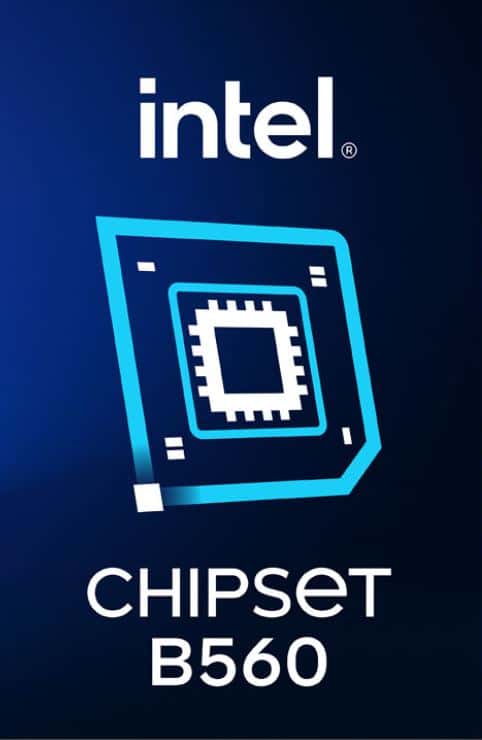
Pros:
- Wi-Fi connection
- Data transfer speeds up to 20 Gb/s
- 128 GB maximum memory capacity
- RAM overclocking support
Cons:
- Only supports Crossfire
- Doesn’t support CPU overclocking
Intel Z590
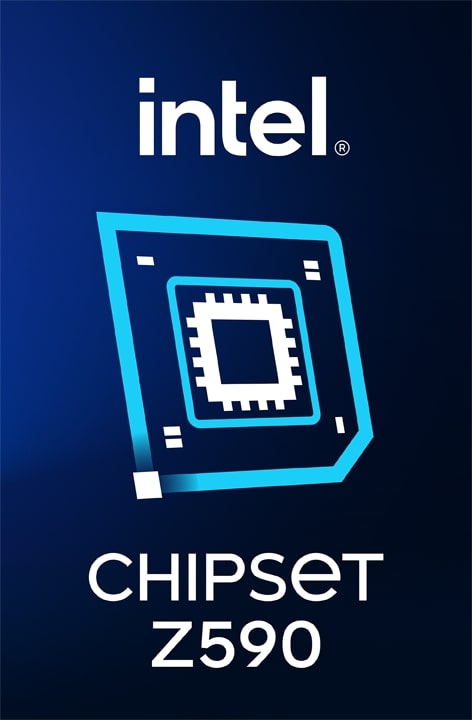
Pros:
- Supports RAM and CPU overclocking
- Lots of USB 3.2 Gen 2×2 ports
- SLI and Crossfire support
- 3200 MHz memory speed
Cons:
- Doesn’t support DDR5
- No support for 12th Gen Intel Core processors
Socket and CPU Compatibility
Socket type supported
Only certain generations of CPUs can fit into a socket type. That’s why you need to pay attention to this segment.
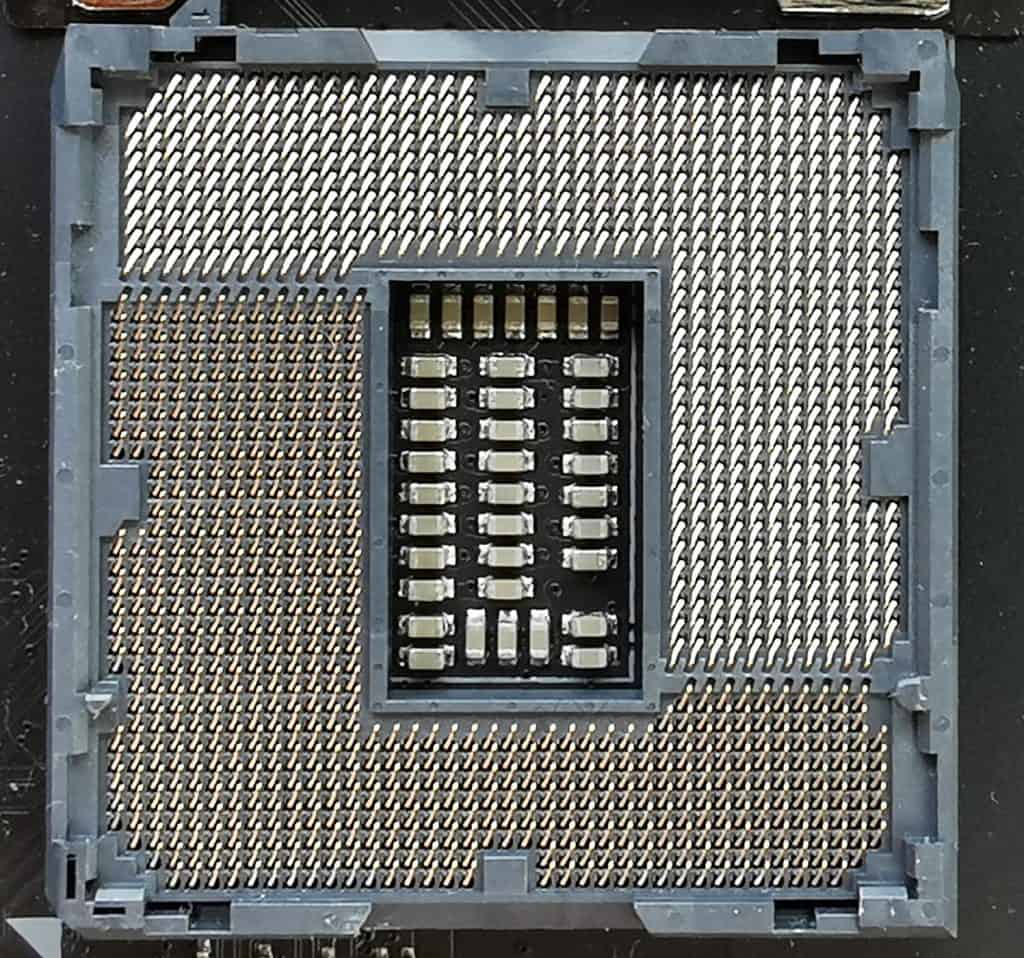
In case you don’t know, the socket allows us to physically connect our processor to a motherboard. In this particular comparison, both chipsets support the same socket. So, whether you choose B560 or Z590 chipset, you need to have an LGA 1200 socket.
CPU support and compatibility
Only compatible CPUs can be paired with a motherboard. Therefore, you should always check the compatibility between these two computer components.
If you are indecisive about which motherboard to choose, maybe you should check which CPU you already have. Check out the video below. It explains how to find out what CPU model you have.
Once you locate this information, check out the compatible processors for each chipset in our B560 vs Z590 comparison.
| B560 Compatible Processors | Z590 Compatible Processors |
|---|---|
| 11th Generation Intel Core i9 Processors | 11th Generation Intel Core i9 Processors |
| 10th Generation Intel Core i9 Processors | 10th Generation Intel Core i9 Processors |
| 11th Generation Intel Core i7 Processors | 11th Generation Intel Core i7 Processors |
| 10th Generation Intel Core i7 Processors | 10th Generation Intel Core i7 Processors |
| 11th Generation Intel Core i5 Processors | 11th Generation Intel Core i5 Processors |
| 10th Generation Intel Core i5 Processors | 10th Generation Intel Core i5 Processors |
| 10th Generation Intel Core i3 Processors | 10th Generation Intel Core i3 Processors |
| Intel Pentium Gold Processor Series | Intel Pentium Gold Processor Series |
The table above shows that both of these chipsets support the same CPU generations. However, it doesn’t come as a surprise since they belong to the same 500 series of chipsets. But neither of these chipsets supports the 12th Generation Intel Core processors.
Form Factor
B560 and Z590 motherboards come in all form factors such as ATX, Micro ATX, and Mini ITX. Choosing from one of these form factors depends on your needs.
For instance, if you want to build a gaming configuration, you want to choose an ATX motherboard. Among other things, an ATX motherboard allows you to place more components which can improve your system performance.
Speaking about form factors, here are some interesting B560 motherboards for you.
| B560 Motherboards | Form Factor |
|---|---|
| GIGABYTE B560 AORUS PRO AX | ATX |
| ASUS TUF Gaming B560M-PLUS | Micro ATX |
As we said earlier, the ATX form factor is the largest. Therefore, if you opt for an ATX motherboard, bear in mind that you will need a larger computer case — either Mid or Full Tower.
Z590 boards, too, come in different form factors.
| Z590 Motherboards | Form Factor |
|---|---|
| Gigabyte Z590 Aorus Elite AX | ATX |
| ROG Strix Z590-I Gaming Wi-Fi | Mini ITX |
Even though Z590 motherboards usually come in ATX form factor, they also come in mid-sized Micro ATX and the smallest form factor Mini ITX. If you choose a smaller form factor, be aware that they come with fewer ports.
Related Read: Full Tower vs Mid Tower vs Mini Tower vs SFF Cases
GPU Compatibility
SLI / Crossfire compatibility?
If you like running multiple graphics cards simultaneously, you might want to get a motherboard that supports this technology. Whether you choose Nvidia’s SLI or AMD’s Crossfire technology, you can slightly enhance the performance of your system.
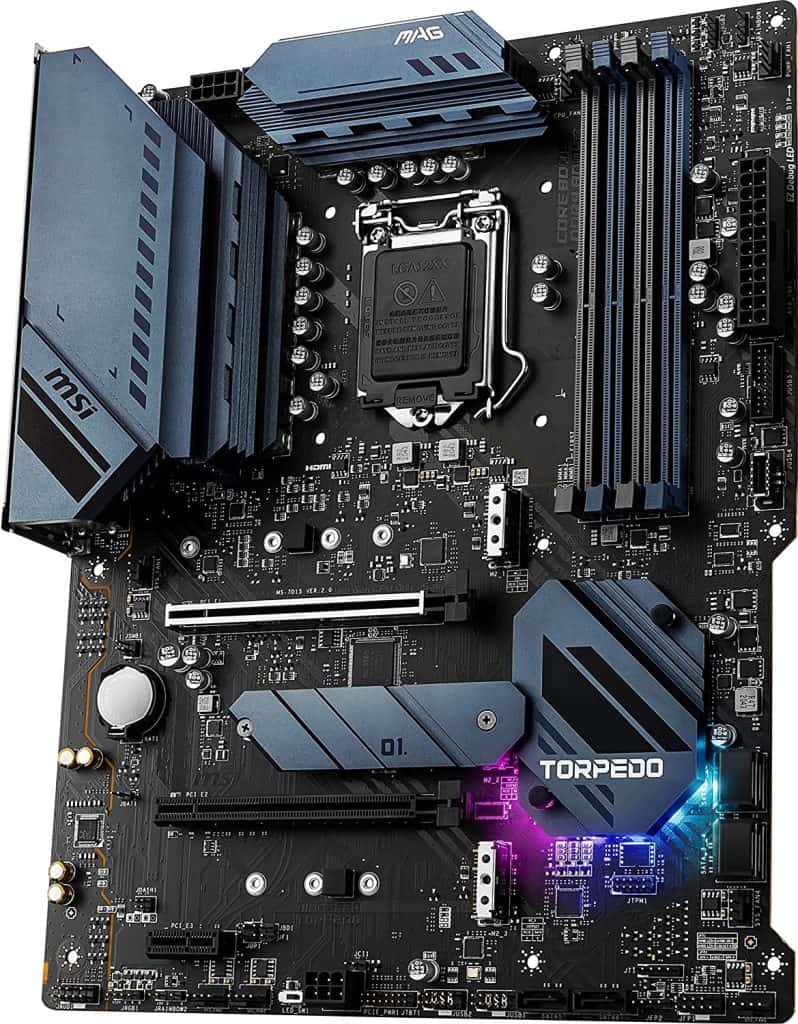
Unfortunately, most B560 motherboards don’t support SLI technology because they usually have only one x16 PCIe slot. But the good news is that there are some B560 motherboards, like the MAG B560 Torpedo, that support Crossfire.
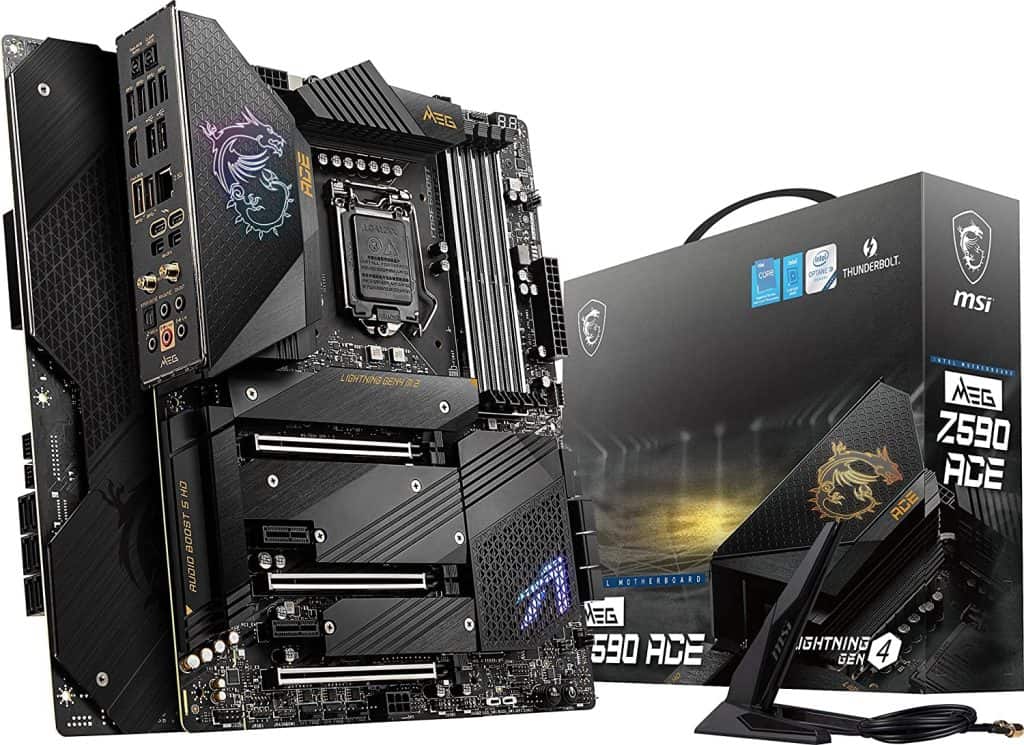
However, Z590 motherboards usually come with dual x16 PCIe lanes, and many of them support Crossfire. But some support both SLI and Crossfire, such as the MSI MEG Z590 ACE Gaming.
Performance
Overclocking
Overclocking is the process of increasing the speed of a computer component over its factory limit. It is recommended to overclock CPUs and/or RAM to elevate your user experience. Both B560 and Z590 chipsets support RAM overclocking — however, only Z590 supports CPU overclocking.
The most convenient way to overclock a component is via the motherboard. If you go down that road, ensure that the motherboard and component support overclocking.
Also, make sure you have a good cooling system installed. Overclocking can cause overheating problems. This is especially important for gamers who need to monitor GPU temp while gaming.
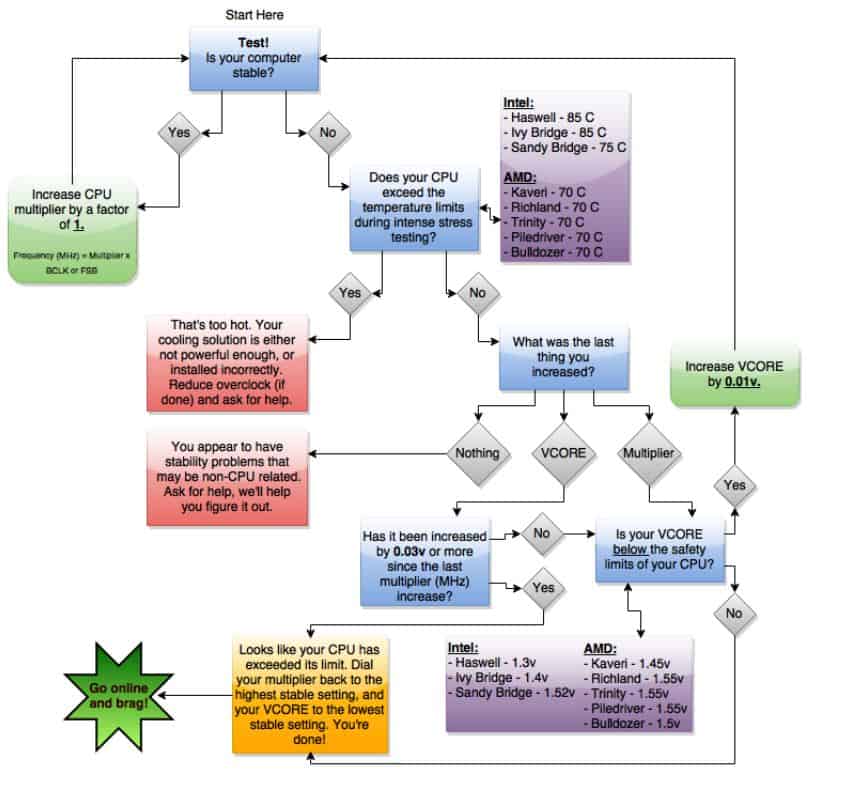
To avoid overheating problems and potential damage, pay special attention to the overclocking flow chart above.
Data transfer speed
The number of USB ports is essential because there are various devices we connect to our computers. Besides the quantity, USB type is also significant when it comes to performance.
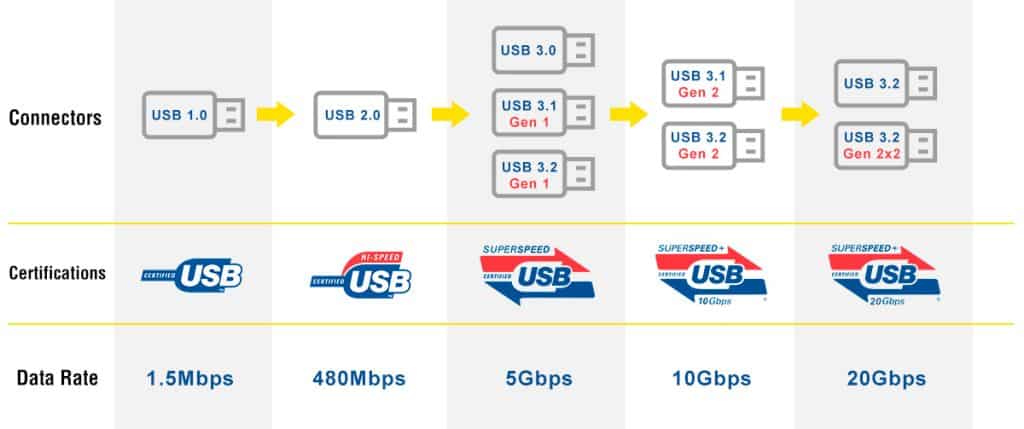
As you can see on the chart above, transfer speeds can vary from 1.5 Mb/s to 20 Gb/s. It is worth mentioning that newer motherboards support USB ports with fast transfer speeds. Let’s compare B560 vs Z590 when it comes to this segment.
| Chipset | USB 2.0 | USB 3.2 Gen 1×1 | USB 3.2 Gen 2×1 | USB 3.2 Gen 2×2 | Total number of USB ports |
|---|---|---|---|---|---|
| B560 | 12 ports | Up to 6 ports | Up to 4 ports | Up to 2 ports | 12 |
| Z590 | 14 ports | Up to 10 ports | Up to 10 ports | Up to 3 ports | 14 |
Obviously, Z590 offers a better choice of USB ports than B560. Not only does it have more USB ports in general, but it has more USB 3.2 Gen 2×2 ports. However, both chipsets support speeds up to 20 Gb/s.
Memory speed and compatibility
Almost all average motherboards support DDR4 memory – 64 gigabytes. In this B560 vs Z590 battle, we don’t have a winner since both chipsets can run 128 GB of RAM.
| Memory Speed & Capacity | B560 | Z590 |
|---|---|---|
| Maximum Speed | 2133 MHz | 3200 MHz |
| Maximum Capacity | 128 GB | 128 GB |
People usually pay a lot of attention to memory capacity — but sometimes, memory speed can help us achieve better system performance.
In that case, the Z590 chipset might be the better choice for you since it supports speeds up to 3200 MHz. The B560 chipset, on the other hand, supports speeds up to 2133 MHz.
Other Features
Wi-Fi compatibility
Since these chipsets belong to the same Intel series, they offer the same Wi-Fi specs. They come with Intel Wi-Fi 6 AX201 support. However, we still recommend you check whether the motherboard you intend to buy supports Wi-Fi.
Connectivity options
Let’s see how these two chipsets compare when it comes to connectivity. These chipsets are the same in terms of SATA ports and transfer speeds.
| Connectivity Options | B560 | Z590 |
|---|---|---|
| Number of USB ports | 12 | 14 |
| Transfer Speed | Up to 20 Gb/s | Up to 20 Gb/s |
| SATA 6.0 Gb/s Ports | 6 | 6 |
| PCI Express Lanes | 12 | 24 |
They are close when it comes to the number of USB ports, but there is a gap between the two when it comes to PCI express lanes. The Z590 chipset has 24 lanes, while its opponent has 12. Each lane allows a speed of 8 Gb/s.
BIOS
Most motherboards require a BIOS update when you want to run a particular processor. And luckily, most motherboards on the market support BIOS updates. That is the case with both the B560 and Z590 boards. You can find BIOS updates on the manufacturer’s website.
B560 BIOS update
Z590 BIOS update
Future-proofing
Future-proofing means choosing computer components that will endure the test of time. So, you can use these components for years to come without worrying if they will support new technologies.
Speaking of future readiness, the Z590 chipset might be the safer choice. Even though they both support DDR4 memory, on Z590 motherboards, the speed can go up to 3200 MHz. In addition, they have up to 24 PCI Express lanes and more USB ports.
Recommended B560 Motherboard
GIGABYTE B560 AORUS PRO AX
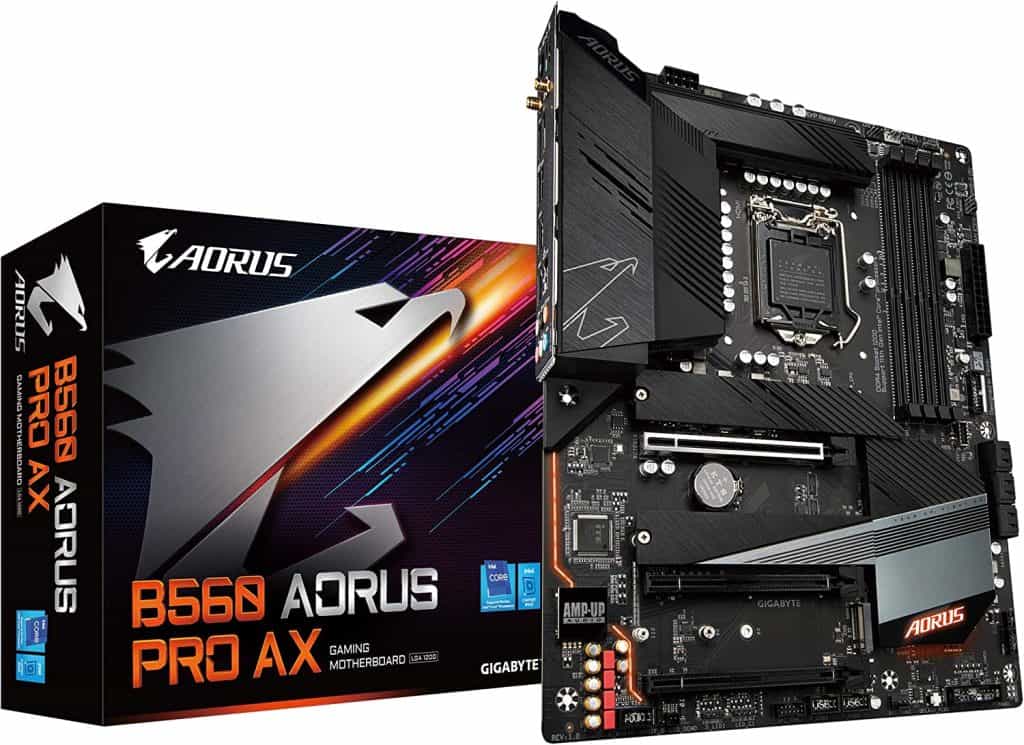
The GIGABYTE B560 AORUS PRO AX supports the 10th and 11th generations of Intel Core CPUs. The form factor of this motherboard is ATX, meaning it is a large motherboard. So, it is suitable for both Crossfire and overclocking. It supports DDR4 RAM, and the maximum capacity is 128 GB.
| Features | GIGABYTE B560 AORUS PRO AX |
|---|---|
| Socket Type | LGA 1200 |
| CPU | 11th and 10th Gen Intel Core Processors |
| BIOS Update | Supported |
| Form Factor | ATX |
| SLI / Crossfire | Crossfire only |
| Overclocking | Yes |
| Memory Type | DDR4 |
| Max Memory Capacity | 128 GB |
| Data Transfer Speed | USB 3.2 Gen2X2 |
Recommended Z590 Motherboard
GIGABYTE Z590 AORUS ELITE AX
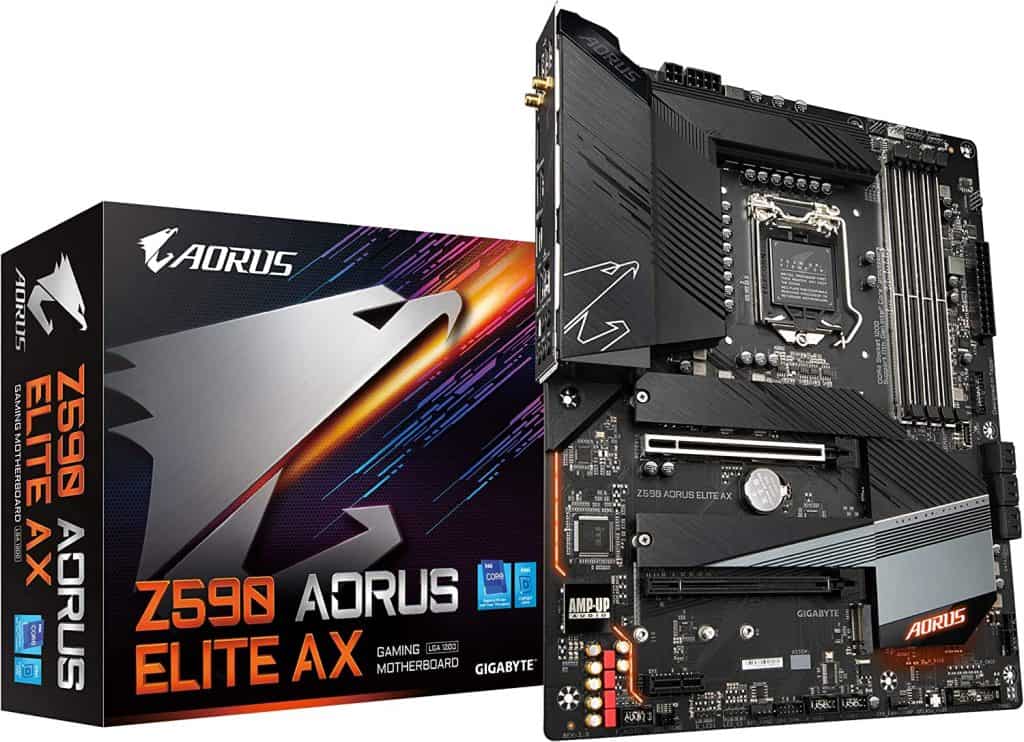
The GIGABYTE Z590 AORUS ELITE AX also supports the 10th and 11th generation of processors. Additionally, it comes with a memory routing system for overclocking.
It supports fast data transfer via USB 3.2 Gen2X2 port. You can place up to 128 GB of DDR4 memory on this motherboard. Another plus for this motherboard is that it supports an LED RGB lighting system.
| Features | GIGABYTE Z590 AORUS ELITE AX |
|---|---|
| Socket Type | LGA 1200 |
| CPU | 11th and 10th Gen Intel Core Series Processors |
| BIOS Update | Supported |
| Form Factor | ATX |
| SLI / Crossfire | Crossfire only |
| Overclocking | Yes |
| Memory Type | DDR4 |
| Max Memory Capacity | 128 GB |
| Data Transfer Speed | USB 3.2 Gen2X2 |
Conclusion
So, which chipset is better, B560 vs Z590? All the information we provided in the article indicates that the Z590 is a slightly better chipset compared to B560.
Let’s start with the B560 chipset. If you don’t want to use overclocking options, the B560 could be a good choice for you. It only supports RAM overclocking, which could be enough if you want to enhance your system performance a bit.
However, keep in mind that B560 motherboards support data transfer speeds up to 20 Gb/s. Therefore, if you want to store your images or videos on external devices, you can be sure that this process will be fast and smooth. 128 GB of RAM can help you run multiple applications simultaneously. So, the B560 is a good chipset intended for affordable mid-range motherboards.
On the other hand, Intel Z590 is a better choice for gamers. It supports RAM and CPU overclocking. Additionally, it can run multiple GPUs. So, if you want to enhance the performance of your system, this chipset brings plenty of options!
Also, data transfer speeds are outstanding since the Z590 chipset has lots of USB 3.2 Gen 2×2 ports. In addition to these USB ports, its maximum memory speed is an impressive 3200 MHz! To conclude, if you want to build a powerful PC configuration, the Z590 is a perfect choice!